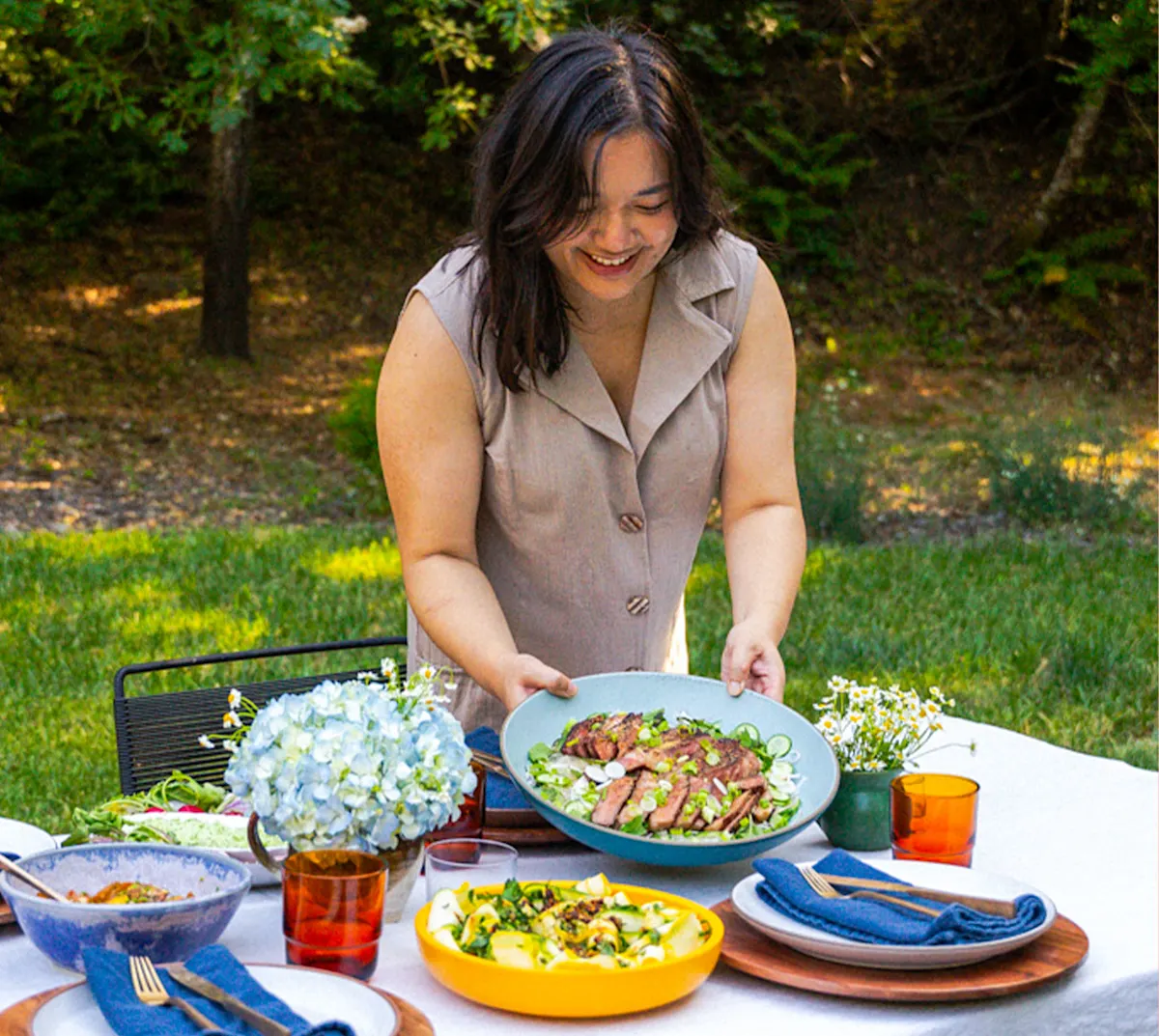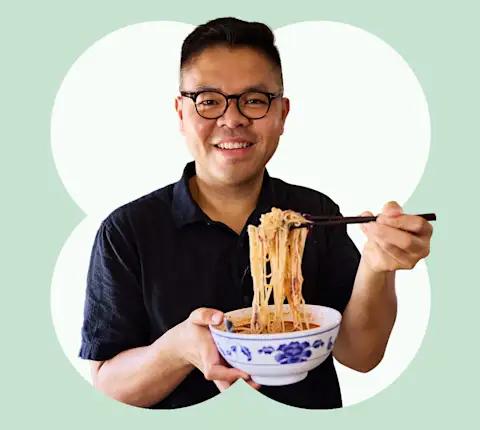“I’m not in my normal house,” says Kristina Cho. There’s a primary-colored abstract painting hanging over her left shoulder, and to the right, dreamy Californian sunshine beams through a tall window. The 32-year-old author and recipe developer normally lives in the San Francisco Bay Area, but when we talk over Zoom, she’s holed up in a woodsy Airbnb “with a waterfall, a pantry filled with vintage treasures…and not a neighbor in sight,” hurtling towards the deadline for her second cookbook.
Despite the mountain of work in front of her, Cho’s laughing and smiling. If you’re on food Instagram — where she’ll teach you how to make luscious frozen peaches bundled in bouncy mochi dough; have you craving a big bowl of crackly, rice noodle-crusted shrimp; or share pictures of her adorable rescue dog, Olive Loaf Cho Alt, then you know her upbeat energy is true to form. It’s a vibe Cho, the two-time James Beard award winner, has spun off into her first cookbook, “Mooncakes and Milk Bread”, as well as the mouthwatering recipes she develops for national media outlets, such as Bon Appétit, Food52, and NYT Cooking.
Cho’s forthcoming cookbook, a manual for sharing family-style cooking at home, will likely hit shelves late in the fall of 2024. It’s a departure from her first, which homed in on Chinese bakeshop foods, like pineapple buns and flaky tarts. Instead, this one is a personal ode to her Chinese-American heritage, and how Cho “strengthens and builds community through food,” she says. As Cho puts it, her cooking style marries “Chinese-rooted traditions and flavors” (see: glass noodle salad with steak), “Midwestern practicality” (see: gussied-up potato salad), and “a sunny, Californian approach to produce” (see: raw zucchini salad with Chinese vinegar and chili crunch).
Her trio of influences and family-style dishes offer a perfect formula for summer picnics, which Cho and her husband typically host every year on their birthdays. “Food just tastes better when you can feel the sun on your skin, when you can feel a breeze,” Cho says. Plus, the setting and balmy weather calls for all the flavors she loves most: “light, crisp, tart, and punchy.” As she jams on her forthcoming cookbook, we asked Cho to walk us through her best picnic-hosting strategies — plus a couple of her go-to recipes. Prepare to be inspired.
Use what you’ve got.
Instead of locking herself into a strict menu ahead of time, Cho finds inspiration from what’s already in her kitchen. During the summer months, “I usually have a ton of herbs, such as Thai basil, cilantro, parsley, and mint,” she says. “So those might inform a subtle vibe that’s botanical and garden-y.” After taking stock of the ingredients she has on hand, Cho orders whatever groceries she needs to fill the gaps. “You don’t have to start completely from scratch,” she says.
Instead of breaking out her dishes into arbitrary categories — as one might when planning a three course, sit-down dinner — Cho likes to check-off various textures and temperatures to ensure snacking variety. She’ll always opt for something with “cold, crisp vegetables,” like radishes and butter; a “rich, creamy salad of some sort,” like roasted potatoes slathered in mayo and spicy sambal oelek; and a (usually warm) focal point “whether it’s a piece of meat or really beautiful produce that’s been treated like a star.” Then, Cho fills the table with nibbles, like cheese and crackers, to make sure nobody leaves the picnic wanting more.
Dessert is non-negotiable.
Okay, there is one category Cho subscribes to. “You have to have dessert at any occasion,” she says, unblinking. Her infallible dessert equation: “Fruit, plus something creamy — whether it’s ice cream, whipped cream, or yogurt — plus a crunchy cookie or flaky pastry, is the perfect end to a meal.” When Cho’s hosting friends for a picnic, she’ll usually opt for a galette with fruit or barely-sweet shortbread cookies guests can layer with fruity jam and soft cheese.
Store-bought is totally fine.
Not even Cho’s picnics are made entirely from scratch. “I’ve recently been embracing frozen puff pastry and premade pie dough if I’m going to make dessert in a pinch,” says Cho. She thoroughly endorses buying pre-cut fruit and vegetables, cheese, crackers, and nuts too. “I also support bagged salads if you’re making a slaw or something like that,” she says, “but make sure you pair them with your own homemade dressings and sauces.”
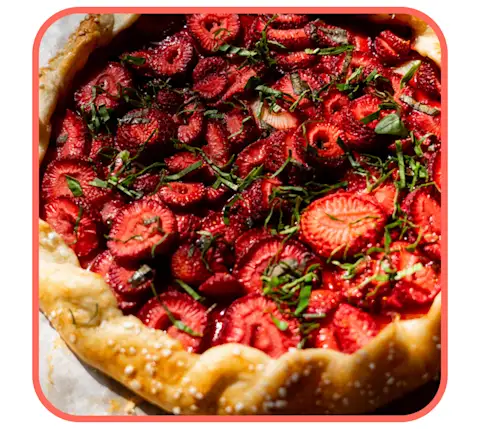
Set the vibe.
Picnics aren’t just about the food (gasp!); you’ve also got to consider the mood. Before setting up your blanket or table and chairs outside, “you definitely need to be aware of how the sun moves,” Cho says. “Is it going to be behind that tree in a couple of hours?” If some guests prefer shade and others like sun, find a spot that’s in the middle. You’re also going to want a stable area to serve your dishes. “Lawns can be a little wonky,” Cho says. So “bring a large cutting board you can use as a flat surface or turn a cooler into a makeshift coffee table.”
To create some ambiance, the cookbook author leans into textures and colors. Start by laying down a picnic blanket or tablecloth “for an extra element of softness,” says Cho. If you have any extra herbs leftover after cooking, pop them — or dainty flowers like chamomile — in little glass jars for the centerpiece. “Botanicals smell really good and they’ll connect you to the food you’re eating,” she explains.
Cho will never host a picnic without bringing certain essentials, including: bug spray or a citronella candle to ward of mosquitos, paper towels to use as napkins and clean up spills, a wine bottle opener (because wine), a trash bag for dumping scraps at the end of the meal, and enough water for people to wash their hands before eating. “I also think it’s good to bring a paring knife, especially if you’re nowhere near your kitchen, in case you need to prep something last minute,” she says.
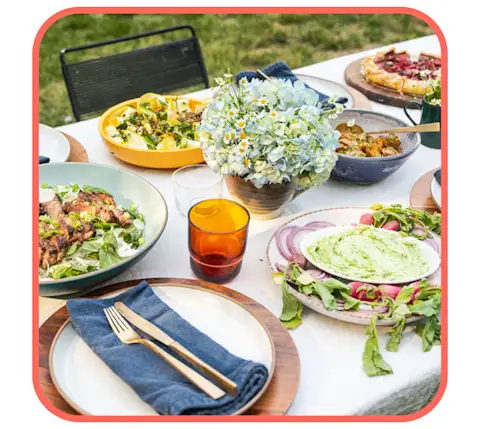
Keep food out of the danger zone.
Eating outside is fun, food poisoning is not. According to the USDA, bacteria grow most rapidly between 40° and 140° F. “Food safety is a big thing for me,” says Cho, adding that she always tries to keep dishes outside of that temperature range, especially when it’s hot out. She’ll typically prepare shelf-stable snacks in advance, but waits until right before guests arrive to cook and serve meat. “I think it’s important to almost work backwards,” she says. “What are the most sensitive foods?”
Cho is also a pro at playing cooler tetris: “I’ll pack mine strategically,” she says, “so the things that really need to be cold are closest to the ice packs.”
Remember to hydrate.
What’s a picnic without some fun bevs? Cho’s drinks of choice are sparkling water, chilled rosé or white wine, and crisp beer. “Those are the options,” she says. That said, “if you are the picnic ringleader, I feel like it’s totally okay to ask your guests to provide beverages — and I always outsource ice to my most reliable friend.”
Now that you’ve got the 101 down, you’re just about ready to host one sweet picnic. If you’re not sure what to cook, Cho has you covered with classic butter and radishes and a hefty, crowd-pleasing salad.
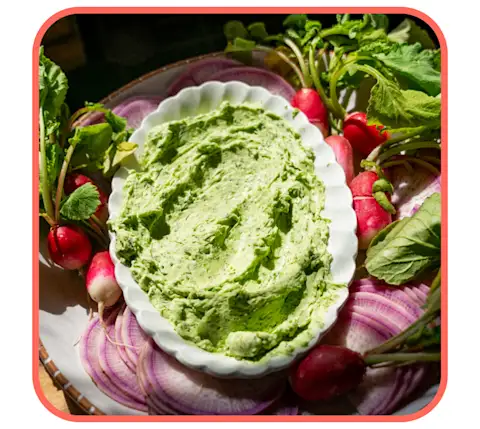
RECIPE: Garlic-Chive Compound Butter With Radishes
For a fresh summer snack that doesn’t require loads of effort, Cho will make a garlicky-green compound butter and serve it with sliced daikon and French breakfast radishes. “It takes like 10 seconds to make, and the crisp, peppery vegetables are perfect with the dense and luscious butter,” she says.
Here’s how to make it:
Add a bunch of Chinese garlic chives or scallions into a food processor and blitz until finely chopped. Add two sticks of softened unsalted butter. Whiz until the “the butter takes on the chlorophyll from the chives and turns a really beautiful green color,” says Cho. Smoosh the butter on a plate, sprinkle it with flaky salt, and surround with halved French breakfast radishes, mandolined daikon — or whatever other crunchy, sturdy vegetables you have lying around.
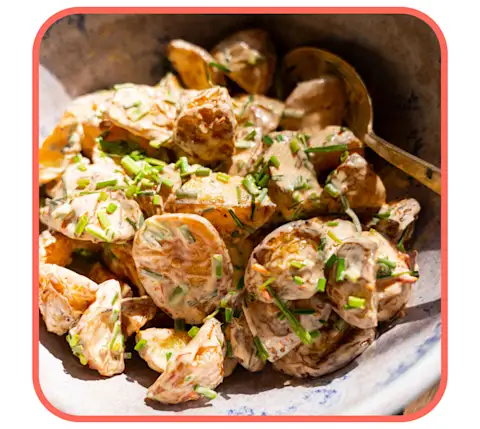
RECIPE: Roasted Potato Salad With Mayonnaise and Sambal Oelek
This is not your average potato salad. A bag of “the smallest, itsy-bitsy potatoes” are baked until fork-tender and coated in a velvety mayonnaise and peppy sambal oelek, an Indonesian condiment typically made from chilies, shrimp paste, garlic, ginger, sugar, and more. It’s a little sweet, a little spicy, and impossible to stop eating.
Here’s how to make it:
Slice the potatoes in half. Toss with olive oil, salt, and pepper and roast in a 400oF oven until crispy but still creamy inside — about 20-25 minutes. Let potatoes cool from hot to warm before transferring them to a medium mixing bowl. Add a big spoonful of mayonnaise —“the amount of mayo that you want in your potato salad is a personal choice,” says Cho — and a small dollop of sambal oelek to taste. Top with chopped chives or thinly sliced scallions. Serve cold or still-warm.
Shop DoorDashPHOTO CREDIT: Courtesy of Kristina Cho


